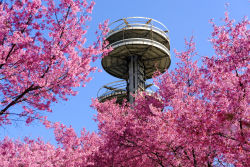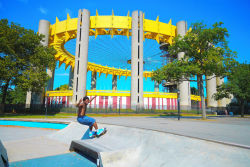Flushing Meadows Corona Park
Flushing Bay Promenade
Once home to Matinecock Native Americans, Flushing Bay has long been an important waterfront in New York City. The Matinecocks, and the European settlers who eventually supplanted them, harvested salt hay, fish, crabs, clams, oysters, and waterfowl from the bay and surrounding wetlands.
During the American Revolution, the Lent Farmhouse stood on the site now occupied by the World's Fair Marina, and British forces occupying Newtown and Flushing used it as the headquarters for the 37th British Regiment. The area's natural beauty made it a popular waterfront resort immediately following the Civil War, and many wealthy New Yorkers built elegant houses here. The infamous concert-saloon-keeper and impresario Harry Hill erected his Flushing Bay Hotel and Pavilion on the World's Fair Marina site, and his steamboat would ply the route between Flushing and his Houston Street Hotel in Manhattan.
By the 1920s, the 1,200-acre Flushing Meadows had been turned into a gigantic ash dump. F. Scott Fitzgerald described the scene in his 1925 novel The Great Gatsby: a "valley of ashes . . . bounded on one side by a small foul river . . . a fantastic farm where ashes grow like wheat into ridges and hills and grotesque gardens." As coal use had increased during the 19th century, the existing wetlands, as well as the creek that flowed from Flushing Bay, were filled to facilitate the site's use as a dump. But Tammany Hall stalwart Fishhooks McCarthy was given sole use of the grounds, and at one point, his Brooklyn Ash Removal Company was unloading 110 railroad carloads of garbage a day to be burned.
Commissioner Robert Moses (1888-1981) used the 1939-40 and 1964-65 World's Fairs, which were held on the meadows, to rehabilitate the area. The Flushing Bay Promenade, a project planned back in the 1980s, is one of the most important additions to the park since the Moses era.
At a time when New York City is reclaiming its waterfront, the promenade dramatically
improves access to Flushing Bay. It is the longest project ever undertaken in
Queens by Parks & Recreation. The promenade stretches 1.4 miles, from the
base of the 27th Avenue overpass to the west to the new $1.6 million boat ramp
to the east.
The Flushing Bay Promenade is bounded by 1.45 miles of railing, and pedestrians
can refresh themselves at one of 17 drinking fountains or rest on the World's
Fair benches - the promenade contains 1,237 linear feet of benches. Nearly six
acres of new sod were laid, along with 1,037 new trees and 10,944 new shrubs
for shade and greenery. 574,264 square feet - 13.16 acres - of new pedestrian
and vehicular pavements were installed, and the promenade is made more attractive
by granite hex block pavers - approximately 365,820 of them, all set by hand.
The promenade was constructed at a cost of $14.8 million, funded by the Department
of Environmental Protection. DEP provided the monies in exchange for Parks allowing
the construction of a new sewer overflow tank in Flushing Meadows-Corona Park.
The tank, which is scheduled for completion in 2002, will prevent flooding in
the area and stop sewer runoff into Flushing River and Flushing Bay.
Aside from its sheer size, the promenade is graced with a number of artistic
flourishes. Seven overlooks provide vantage points over Flushing Bay, and they
are each marked with eight graphic panels designed by artist Gregg LeFevre.
The panels depict one plant and one animal species for each letter of the alphabet,
for a total of 52, with an additional panel at the start and end of the promenade.
At the eastern end of the promenade, near the World's Fair Marina's Pier One,
artist Jackie Ferrara has enhanced the soaring white shade structures - known
as Candela structures for the artist Felix Candela (1910-19__) who designed
them for the 1964-65 World's Fair - with a complementary abstract geometric
paving pattern. Ferrara's design also includes special benches, an in the artist's
words, the project as a whole is meant to "be a part of, include, and interface
with the site . . . reflect the topography, the functions, and the history of
the area . . . and pay homage to the memory of the World's Fairs.
The Flushing Bay Promenade is a long-awaited improvement of FMCP. It provides
visual access to the bay, and will have a salutary effect on the relationship
of residents of Queens and visitors alike to a historic part of the waterfront.
Check out your park's Vital Signs
Clean & Safe
Green & Resilient
Empowered & Engaged Users
Share your feedback or learn more about how this park is part of a
Vital Park System

Know Before You Go

Downloads
- New York State Pavilion Listening Session
- Strategic Framework Plan: Introduction
- Strategic Framework Plan: Site Analysis
- Strategic Framework Plan: Conceptual Framework, Part I
- Strategic Framework Plan: Conceptual Framework, Part II
- Strategic Framework Plan: Vision and Goals, Part I
- Strategic Framework Plan: Vision and Goals, Part II
- Strategic Framework Plan: Appendix, Part I
- Strategic Framework Plan: Appendix, Part II
Links
- National Tennis Center Strategic Vision Project
- World Ice Arena
- Citi Field
- Mets Ticketing
- USTA National Tennis Center
- US Open
- Terrace on the Park Catering Hall
- New York Hall of Science
- Queens Museum
- Queens Botanical Garden
- Queens Theatre
- Queens Wildlife Conservation Center
- Fantasy Forest at the Flushing Meadows Carousel
- Wheel Fun Rentals
- Alliance for Flushing Meadows Corona Park
Contacts
General Park Info: (718) 760-6565
Pitch N Putt Golf and Miniature Golf : (718) 271-8182
World's Fair Marina on Flushing Bay : (718) 478-0480
World's Fair Marina Restaurant: (718) 898-1200
Terrace on the Park: (718) 592-5000
Citi Field: (718) 699-4220
Mets Ticketing: (718) 507-TIXX
USTA National Tennis Center: (718) 760-6200
US Open/USTA: (914) 696-7000
New York Hall of Science: (718) 699-0005
Queens Museum: (718) 592-9700
Queens Botanical Garden: (718) 886-3800
Queens Theatre: (718) 760-0064
Queens Wildlife Conservation Center: (718) 271-1500
Sports Permits: (718) 393-7272
Picnic/Barbeque Permit for Large Groups: (718) 393-7272
Wheel Fun Rentals: (917) 231-5519
World Ice Arena: (718) 760-9001
Al Oerter Recreation Center: (718) 353-7853
Flushing Meadows Corona Park Pool & Rink: (718) 271-7572
Special Events Permits: (718) 760-6560
Tennis Permits: (718) 393-7276
Volunteer Coordinator: (718) 760-6561










